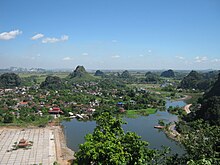Ninh Bình (Province)
| Tỉnh Ninh Bình | |
|---|---|
| Provincial capital: | Ninh Bình |
| Region: | North Vietnam ( Bắc Bộ ) |
| Region: | Đồng Bằng Sông Hồng |
| Surface: | 1,390 km² |
| Residents: | 953,100 (2016) |
| Population density : | 686 inhabitants / km² |
| Chairman d. People's Council: | Nguyễn Tiến Thành |
| Chairman d. People's Committees: | Bùi Văn Thắng |
| License plate : | 35 |
| map | |
Tỉnh Ninh Bình is one of the smallest provinces in Vietnam . The capital is Ninh Bình . In the province of Ninh Bình was the economic and political center of Vietnam in the 10th century with the old imperial city of Hoa Lư .
geography
Ninh Bình Province is located south of the Red River Delta , between the Red River and the Ma River . It is bordered by the provinces of Hòa Bình and Nam Định in the north, Hà Nam in the northeast and Thanh Hóa in the south and west. The coastline on the Gulf of Tonkin is very short.
The cone and tower karst landscape of the Tràng An in the "dry Halong Bay" is located immediately west of the city of Ninh Bình and is a world cultural and natural heritage . Tràng An was added to the list of UNESCO sites in 2014 and is the only one with dual status in Vietnam to date. Also worth seeing is the Bái Đính Pagoda , which is located in the northeast buffer zone of the world cultural heritage. The over 500 hectare complex includes several temples and a 100 m high Bai Đính tower that houses relics of the Buddha.
The Cúc Phương National Park is 62 km northeast of Ninh Binh . It was opened in 1962 as the first national park in Vietnam and is now the sixth largest national park in the country.
climate
The average temperature of the moderately humid and warm region is 23.4 ° C. Annual precipitation is around 1800 mm with a maximum in August and September.
Demographics
23 ethnic groups live in the province, the majority of which are the Viet / Kinh (98%) . Larger groups of Dao , Hoa , Mẹo or Hmông , Mường , Nùng , Tày and Thái also live there .
Administrative structure
The ISO 3166-2 code for Ninh Bình is VN-18 , the Hierarchical administrative subdivision code (HASC) is VN.NB. The province is divided into the city of Ninh Bình , the city of Tam Điệp and the following six districts: Gia Viễn, Hoa Lư, Kim Sơn, Nho Quan, Yên Khánh and Yên Mô. The telephone area code is +84 (0) 30, the postcode is 43xxxx and the license plate number is 35.
Infrastructure
National roads 1A and 10 run through the province. Ninh Bình has an express train connection to the capital Hanoi, 91 km away, as well as bus routes to the south bus station in Hanoi. Express trains to the south of the country go to Thanh Hoa and Vinh. Ninh Phúc river port is the largest in Vietnam.
Culture and craft
Well-known festivals in the province are the Thai Vi Festival, celebrated in the third month of the lunar calendar in Ninh Hai Commune, Hoa Lư District, the Truong Yen Festival, the Yen Cu Festival and the Non Khe Festival. Noteworthy handicrafts are the embroidery from the Hoa Lư district and reed grass work from the Kim Sơn district.
Attractions
The ancient capital of the Đại Cồ Việt Empire and the citadel near Hoa Lư in the Trường Yên municipality are of particular historical interest. From here, founded by the governor of Ninh Bình, Đinh Bộ Lĩnh (also Đinh Hoàn), whose ruler name was Đinh Tiên Hoàng, the second Vietnamese dynasty of the Đinh and the early Lê dynasty ruled from 968 to 1009 . This was overthrown in 1009 by Lý Thái Tổ , who moved the capital from Hoa Lư to Thăng Long , today's Hà Nội.
The old town of Ninh Bình and the stone church in Phát Diệm Diem in the Kim Sơn district are well-known historical sites in Vietnam. Also worth mentioning are the caves and jungle of Cuc Phuong in the Nho Quan district, as well as the pagoda and cave of Dich Long in Gia Thanh, Gia Viễn district. Other historical buildings: the Can Linh, Banh Long and Nhat Tu pagodas as well as the Thai-Vi and Dinh Le temples.
The Bái Đính Pagoda, the largest pagoda and temple complex in Vietnam, is currently being built near Hoa Lư in the Gia Sinh commune, Gia Viễn district on 700 hectares. In the lower pagoda Điện Thờ Pháp Chủ stands the largest Buddha statue in the country, weighing over 100 tons. The construction work should be completed for Hanoi's 1000th anniversary in 2010.
The Ninh Binh Bear Sanctuary was completed in 2017 and opened to visitors in 2019. This is also intended to create a place for animals from the illegal production of bear bile .
gallery
Phát Diệm Church in the Kim Sơn district
Web links
- Administration website in Vietnamese
Individual evidence
- ↑ Provinces
- ↑ UNESCO World Heritage Center: Trang An Landscape Complex. Accessed July 15, 2018 .
- ↑ Bear Forest Ninh Binh from April 16, 2020 in Vier-pfoten.at
Coordinates: 20 ° 15 ' N , 105 ° 50' E











